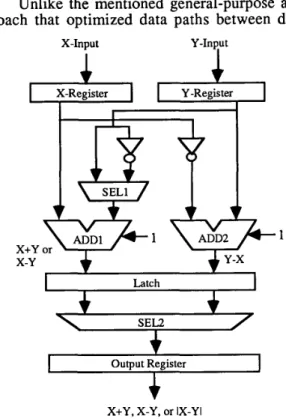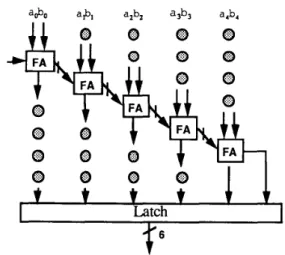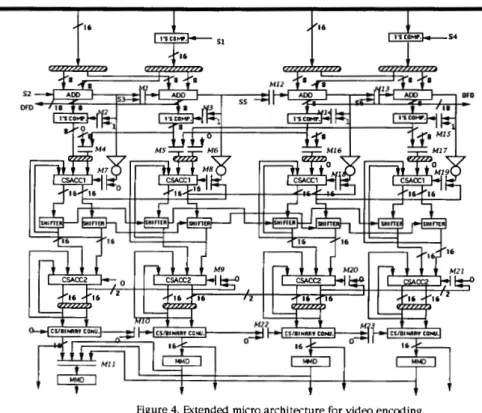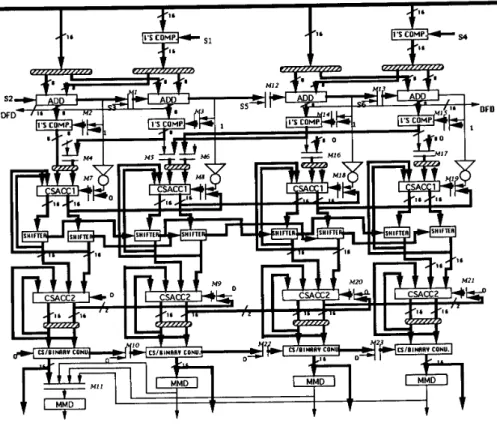AN AREA/TlME-EFFICIENT MOTION ESTIMATION MICRO CORE* Sau-Gee Chen
Department of Electronics Engineering National Chiao Tung University
Hsinchu, Taiwan, ROC
Abstract- An efJicient micro architecture for mo- tion estimation is proposed. I t achieves better time and area performance than the existing structures. Through pipelining and effective ma- nipulation of 2's complement arithmetic, the adder complexity is kept to its lowest, while speed for
a
combined subtraction, absolution and ac-cumulation operations is made as fast as a carry- save addition (CSA). Together with a new DCT algorithm, the micro structure is further ex- panded and tailored to facilitate efficient execu- tion of other video operations like DCT and filtering operations.
I. INTRODUCTION
Video encoding demands huge amount of real-time computation, especially for the motion estimation (ME) operation with full search block matching, and the multiplication-intensive dis- crete cosine transform (DCT) operation. Other multiply-and-accumulate type of operations such as filtering, and matrix operations are also com- mon in general signal processings. For real-time video signal processing such as HDTV encod- ing/decoding to become a reality, design of effi- cient architecture for those operations is indis- pensable.
Among those operations, motion estimation is the most time-consuming one. For instance, as- sumed that the minimum absolute error (MAE) cost function is used, and a 16x16 block with a block matching of search range from +M to -M in both spatial directions, then there will be total 512 x (2M
+
1)2 addition operations for every*
This work is supported in part by National Science Council under Contract NSC82-0404-EO09- 154, and Computer and Communication Laboratory of ITRI.motion vector generated. On the other hand, total numbers of multiplication and addition required for a 16x16 block are about 4096, based on direct row-column matrix multiplication. From the given figures we can show that time required for ME rapidly exceeds that of DCT for even moder- ate M. Note that this comparison does not con- sider the existence of more efficient DCT algo- rithms and high memory bandwidth required for ME operations. For more efficient encoding, M has to be as large as possible. Consequently, the ultimate bottleneck for real-time video encoding lies in time-consuming ME operation.
The known architectures for ME in the lit- erature can be divided into two classes. The first class is the ASIC array processors that utilizes the regular and repetitive properties of ME opera- tions. The second class is designed by optimizing data paths between different function blocks of a general-purpose video signal processors (VSP). Here in this paper, we adopt the general-purpose approach for the consideration of programmabil- ity and practical implementation.
An ideal ME core is required to efficiently perform various functions, including addition, subtraction, absolution and accumulation opera- tions. Figure 1 depicts a conventional ME core. The structure provides parallel adders for fast ab- solution, but is area consuming. It requires two selectors, two adders, and two 1's complement circuits. Goto et al. [ 11 eliminates one of the se- lectors at the expense of one more adder. Kikuchi et al. [2] provided a relatively efficient hardware for absolute operation only, but still requires two adders and one selector. Moreover, all the men- tioned designs do not include the accumulator for total sum of these absolute differences. They did not take advantage of the correlation between the adder for absolution and its accumulator.
Manuscript received June 11, 1993
1
~~11
I
Chen: An Area/Time-Efficient Motion Estimation Micro Core 299
11. THE ME CORE
Unlike the mentioned general-purpose ap- proach that optimized data paths between dif-
X-Input Y - I n p
I Outuut Register I
+
X+Y, X-Y, or IX-Y I
Figure 1. Conventional micro structure for motion estimation.
ferent function blocks, we optimize the ME func- tion block from within the bottom circuit level. Then the optimized design is extended to the higher block-level optimization, by taking into account of other operations like DCT and filter- ing.
Through pipelining and effective manipula- tion of 2's complement arithmetic, complexity of the micro architecture is kept to its lowest, while time spent for a combined subtraction, absolution and accumulation operations is made as fast as a CSA (carry-save addition).
The efficient micro architecture for ME (to be detailed later) is small in area and fast in speed, while it is flexible enough to execute vari- ous different operations for video signal process- ings. In particular, we will also present a new matrix-based DCT algorithm, that can be effi- ciently computed by this hardware. The new DCT algorithm costs only 288 multiplications for an 8x8 subblock.
Figure 2 shows the data paths of the ME core. The ME core basically consists of two sim- ple adders. The first adder is the ADD module that executes x - y operation for difference of frame displacement (DFD), and x
+
y operation for motion compensation. Operation Ix - yl for MAE is not explicitly computed, but are carried out altogether with the operation256
C1.n
-
Y J in the second adder Zodule CSACC.X-Input Y-Input
OVR
TO DFD memory
.
Figure 2. Proposed micro core for motion estimation. This configuration replaces the slow 2's comple- ment operation for absolute value of x-y with the simple 1's complement operation and addition of 1 to LSB in the CSACC module. Signal OVR is the output carry generated from ADD module, indicating a negative result of x - y if OVR=O, positive otherwise.
Due to repetitive nature of block matching operations, a highly pipelined adder is desirable. Figure 3 shows a fully pipelined parallel adder realization for ADD module. The adder's cycle time can be made as short as a CSA time, or as large as a carry-ripple addition time without re-
adders
1's compl. ckts selectors
Functions
sorting to CLA or any other fast addition schemes that are area consuming.
a&, a&, a,%
. .
proposed e n v e n - Goto's Kikuchi's
1 2 3 2 2 2 2 2 0 2 1 1 tional Ix-yl Ix-yl I x - y l Ix - yl X f Y x f y x f v
1
Table 1 summarizes the occupied area for the proposed and known architectures. As shown, the proposed architecture has the lowest hardware complexity. Moreover, adders of the whole ME core are simple CSA, CPA adders and bit-serial adders.
Figure 3. Fully pipelined bit parallel adder with 6-bit wordlength.
Since CSACC module is based on CSA, it is free of carry-propagation delay. As such, time spent for ME is greatly reduced. The accumulator outputs an absolute error every 256 CSA cycles for a 16 x 16 block matching. Thus, conversion of output from CSA to binary is accomplished in the converter, that is only a simple bit-serial full adder. The conversion is finished in N out of 256 CSA addition cycles for an N-bit binary output. The MMD module updates the minimum absolute error by comparing the currently mini- mum error with the error of the newly matched block, bit serially starting from LSB. Similarly, MMD module can be realized by a bit-serial full adder.
Assume that one CSA time consumes at most several nano seconds, say 4ns, then a 250MHz clock rate will be required to exploit the speed advantage. Modest process and circuit de- sign technology may not achieve smooth opera- tion under such speed. Alternatively, we can con- struct the pipelined adder based on a simple m-bit carry-ripple adder (CPA), instead of the 1-bit full adder. The length of CPA is the one that the result CPA time best matches the shortest cycle time the design environment allows and guaran- tees smooth operation. The benefits of this ap- proach are the reduction of pipeline latches and elimination of a complicated adder.
Table 1. Comparison of area complexities of the new struc-
ture and existing structures.
111. EXTENDED MICRO CORE FOR VIDEO ENCODING
By taking advantages of the micro architec- ture, we can duplicate as many modules as possi- ble, subject to design constraints, to facilitate ef- ficient executions of other encoding operations. Figure 4 depicts such a general-purpose VSP structure based on four ME cores. The architec- ture is tailored to both ME and multiply-and-ac- cumulate (MAC) type of operations such as DCTDCT, quantization, and filtering.
Supporting circuitry such as multiplexors are added to program the data paths for different operations. Multiplication operations are carried out in the unit based on the shift-and-add operations with the supports of shifters and Booth's recoding. The architecture executes one MAC operation at a time. Module CSACC2 is for summation of products produced by CSACC1.
Figure 5 shows the data paths of the func- tion unit when it is programmed to ME function, as is highlighted by bold lines. The ME function is to find the minimum of ZIX-YI. Four ME modules operate independently and simultane- ously. In order to execute IX-YI, the control sig- nals S1 and S4 of the first 1's COMP module are set to "0". Meanwhile, signals S2, S3, S5, and S6
are set to "1" and selected by multiplexers M1, M12, and M13 respectively. On the other hand,
I
301
Chen: An Area/Time-Efficient Motion Estimation Micro Core
M2, M3, M14, M7, M8, M18, M19 and M15 all select the upper inputs. The carries out from ADD modules are used to control the second 1's complementers. The carry and the sum vectors of CSACCl are pass through modules SHIFTER and CSACC2 unchanged. Whereas M10, M22, and M23 select the lower input data "0".
When doing DCT, quantization, or filtering operations, all four ME cores are connected to- gether as shown in Figure 6. This configuration supports 16-bit by 16-bit and 24-bit by 24-bit MAC operations. Precisions of results can be as high as 64 bits. The left CSACCl is cascaded to the right CSACCl as a 64-bit accumulator. The carry and the sum vectors from CSACCl are shifted right by 2 bits then accumulated in every cycle. CSACC2s are used to accumulate the results of the multiplication results from CSACC1.
IV. AN EFFICIENT DCT ALGORITHM FOR THE MICRO ARCHITECTURE
An efficient DCT algorithm is proposed here, which can be effectively executed by the micro architecture. Given NxN 2-D video signal X and its 2-D DCT in matrix form
z
= CTXC where elements of C are defined as1
(2k - 1)(1- 1)n Ck.1 = E c o s [ 2N for k = 1,2,..-,N,l= 2,3,---,N, N I 4 N I 4 Uk.2mUk,2m-l-
C2m-l,lC2m,1 N I 4 N I 4 'k,2mVk,2m-l-
C2m-l,lC2m,l m=l m=lfor odd and even 1 respectively. The total number of multiplications required is O(N3/4). For typical 8x8 block, only 288 multiplications are required. This reduces the time for DCT con- siderably. Although this algorithm consumes more operations than the existing optimal algo- rithms, it is free of complicated data routing for butterfly operations like the latter algorithms.
Since DCT is performed either on input video data or on DFD which are integer values, the addition of signal data to DCT constants which are purely fractional, may greatly increase the dynamic range required by hardware when implementing this DCT algorithm. The problem can be easily solved by scaling the input data to be purely fractional. Final results are then scaled up to its correct value.
V. CONCLUSION
and c k , l = N-'I2 for 1 = 1 In this work, we proposed an micro struc-
ture for video encoding, and an efficient regular D m algorithm for the architecture. Although ef- ficient in its function alone, its overall perfor- mance is subject to good designs of the support- ing memory systems. This is a crucial issue that is currently under simulation and investigation It can be computed by the well-known row-
column approach. It is also widely known that the matrix multiplication
y=xc
can be simplified asN I 2 Yk.1 = c'k.m'm.1
m=l
REFERENCES
[l] Goto, et al., "250 MHz BiCMOS Super- High-speed Video Signal Processor," IEEE JSSC, Dec. 1991, pp. 1876-1884.
Kikuchi, et al., "A Single-Chip 16-bit 25-ns Real Time Video/Image Signal Processor," IEEE JSSC, Dec. 1989, pp. 1662-1667. N I 2 Yk.1 = ~ ' k , m C m . l m = l [2] for 1=2,4,---,N, with vkVm = x ~ . ~ - x ~ , ~ - ~ + ~
where y k , , is the element of Y.
t6
A-
1's conr. s4Figure 4. Extended micro architecture for video encoding.
I
Chen: An Area/Time-Efficient Motion Estimation Micro Core
Figure 6. Data path for DCT operation
Sau-Gcc Chcn received the B.S. degree in Nuclear Engineering from the National Tsing Hua University, Taiwan, in 1978, the M.S. degree and Ph.D. degree in electrical engineering, from the State University of New York a t Buffalo, NY, in 1 9 8 4 and 1988
respectively.
He currently holds a joint appointment as an Associate Pro- fessor of the Microelectronics and Information Science Research Center, and the Department of Electronics Engineering, National Chiao Tung University, Taiwan. His research interests include digital arithmetic, digital signal processing, and VLSI system design



